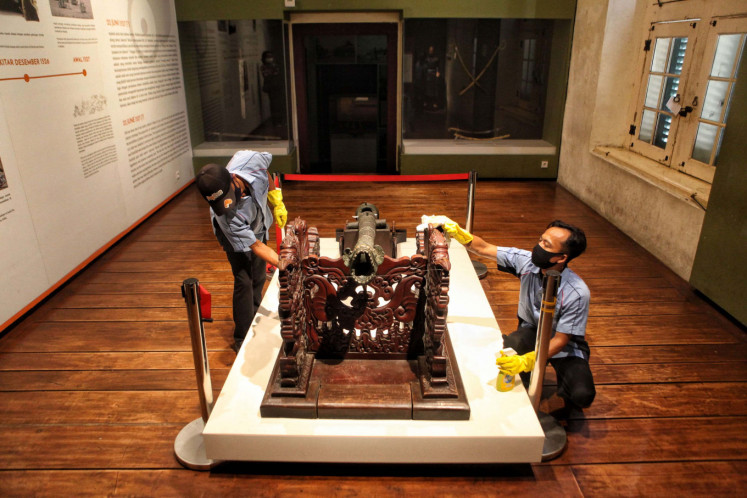Nancy Margried: Batik + Math = Innovation
A woman's advice is no great thing, according to an old proverb, but he who won't take it is a fool
Change text size
Gift Premium Articles
to Anyone

A woman's advice is no great thing, according to an old proverb, but he who won't take it is a fool.
Perhaps architect Muhammad Lukman and mathematician Yun Hariyadi were aware of this when their friend Nancy Margried criticized their poor self-presentation.
Nancy met Lukman after he held an exhibition of his mathematics-based architectural works at a caf* in Bandung.
"I believe he has a brilliant mind but he presented it in such a bad way that nobody would even look at *his works*," Nancy said.
She and Lukman became friends, with Lukman later introducing her to Yun Hariyadi.
"He also has a brilliant mind but I didn't really understand what he said," Nancy said laughing.
"For me, something has to be able to be understood if we want to make it useful for people," added the public relations expert from Medan in North Sumatra. "When it comes to design, never make it too weird or people won't look at it."
Nancy became fast friends with the two men despite their different professional backgrounds, with the trio finding a common interest in visual art and hanging out in cafes.
And that was how it came about that Lukman, then doing his doctoral dissertation on architectural designs generated from fractal formulae, showed his friends pictures generated by mathematical formulae.
"The pictures looked like flowers and plants and to me they looked like batik," said Nancy, now 30. "We wondered if batik could be made from a mathematical formula."
Her idea set off a series of experiments and consultations with batik experts, with their research proving that batik does indeed have a mathematical pattern.
So excited were they by where their discovery might lead that Nancy resigned from her position as marketing communications director at a property agent in Bandung to concentrate on the project.
Then in early 2007, the research well under way, the trio submitted a proposal to show their work at the 10th Generative Art International Conference in Milan, Italy, in December 2007. To their surprise, they were invited to the conference.
Panicking at what they had got themselves into, they worked harder on their research tasks, including preparing a research abstract, developing new software to make their thesis applicable and generating batik samples using the software.
"We had to create our own software because no *existing* software in the world could do what we wanted," Nancy said, adding the team also consulted batik experts at university to help them with the philosophical, historical and artistic aspects of batik.
They also needed a banner, and came up with the name "Pixel People Project Research & Design".
Less easy to get was the money they need to attend the conference.
"I knocked on the door of every government department, educational institution and private company," said Nancy. "Some didn't even understand what we doing with math and batik. Others said it was a good effort but didn't give us a penny."
The West Java provincial government finally gave Rp 60 million, but it was enough to send only Lukman and came so late he arrived when the conference had finished. Instead, he presented their findings to the board of committee.
"We received a very good response . because we were the only group to combine something as traditional as batik and something as modern as mathematics and computer technology. Other groups relied only on their advance in computers," said Lukman.
"We also came with a research paper while other participants only talked about possibilities based on trial and error. We proved that batik is mathematical; we have the software and brought the product."
The conference boosted the trio's confidence that their project had a future and would be useful for many people and many disciplines.
The State Ministry for Research and Technology gave them a Rp 75 million grant early in 2008 for software development and to arrange a solo exhibition in Bandung and participate in international and national exhibitions.
Their software, jBatik, processes traditional batik design patterns into millions of new motifs using a fractal mathematics formula.
However, the business side of the project was still flimsy. Perhaps, Nancy said, "because we hadn't received much publicity and our batik stock was limited."
Nevertheless, they won the 2008 Indonesian ICT Award and Unesco's Award of Excellence at the 2008 Asia Pacific ICT Awards, out of a field of 70 entrants from 10 Asia-Pacific countries.
One of their products is now on permanent display at the Unesco Gallery in Bangkok.
They were again hampered by financial problems, and were helped by a US$25,000 grant from Senada-USAID. After four months of development, the advanced software was launched in Bandung in May, attended by the State Minister for Research and Technology Kusmayanto Kadiman.
"I am impressed because the innovation could expand batik sales extensively," Kusmayanto said at the launch. "Batik, which was regarded as traditional and old-fashioned, can now become a trend among young people with its new and up-to-date designs."
Today, the software is sought after by consumers in Australia, the United States and Singapore. The batik designs generated have been applied not only to garments but also to shoes and furniture.
The Pixel People Project provides companies with software, training and design and also provides individual customers with fractal batik products through a partnership with two companies in Bandung - Rumah Batik Komar and Studio Batik Hassan.
From a friendship to a project, the Pixel People Project has ended up with something sophisticated in structure and design and applicable to many.
"Not many people will have the advantage of mathematical formulae if they are only applicable for architecture," Nancy said. "Batik is something very common in our society."









